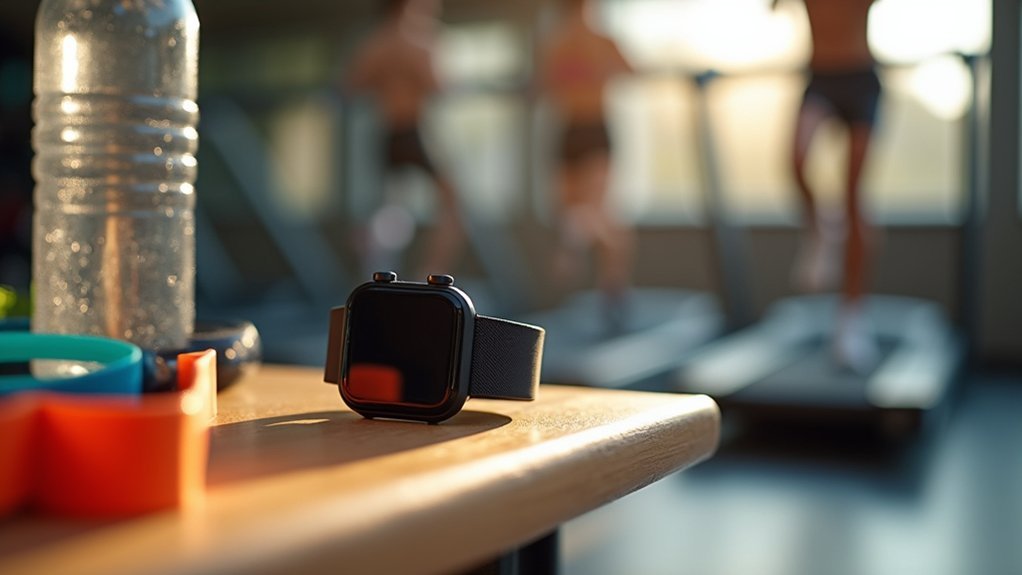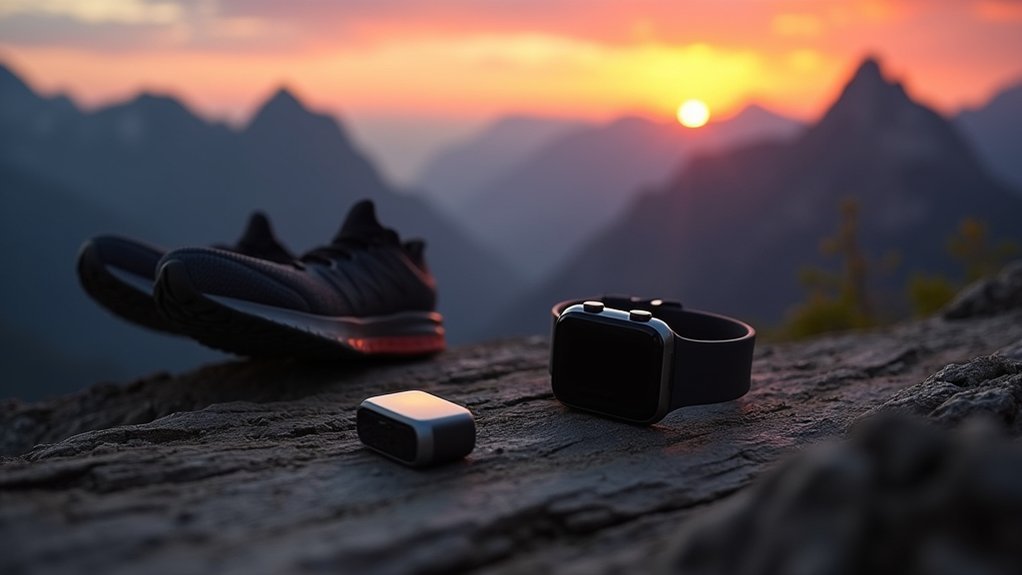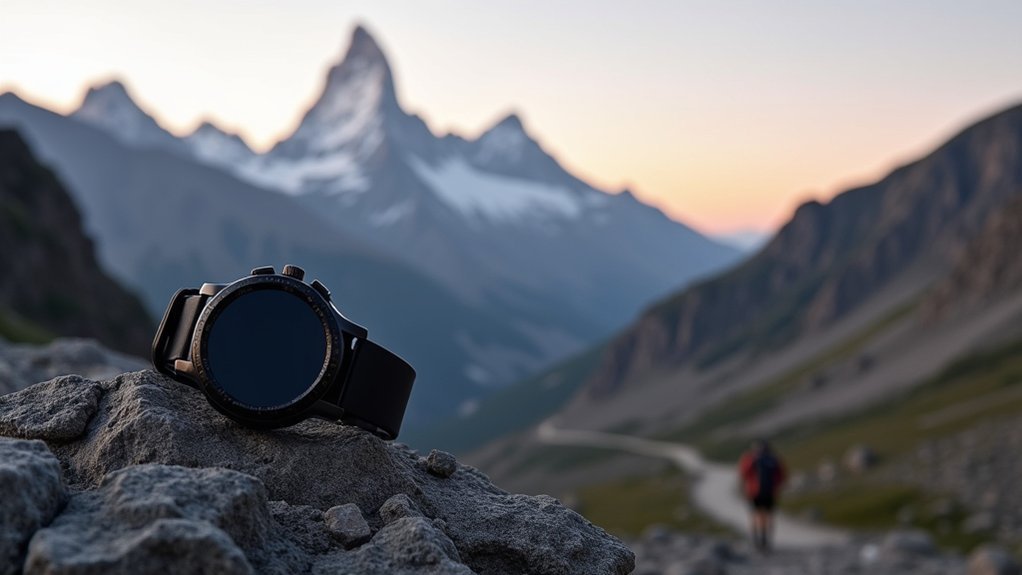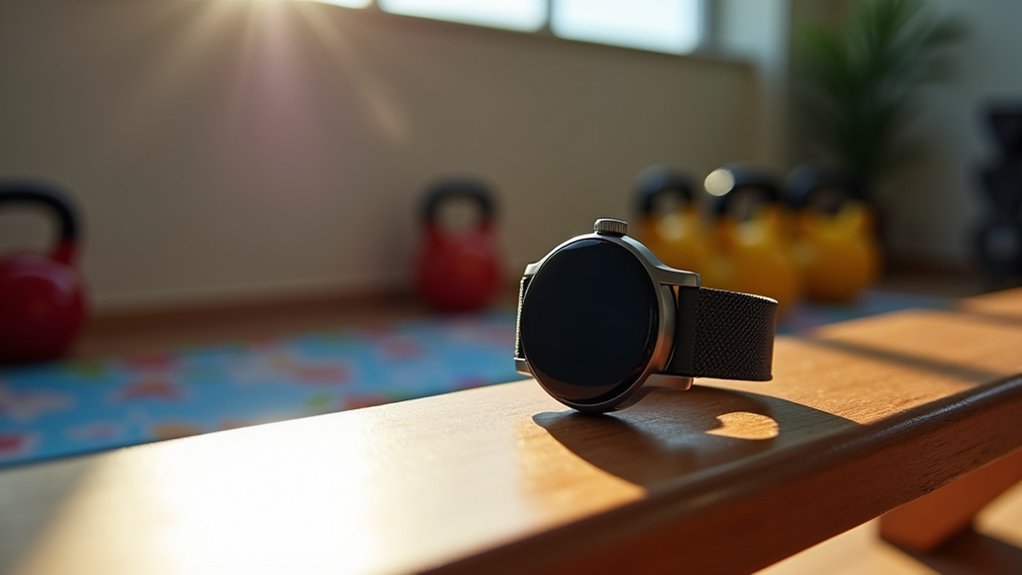For elevation training, you’ll want a watch with both accurate cardio monitoring and reliable altitude tracking. The Garmin Forerunner 965 offers precise GPS and barometric altimeter readings, while the COROS Apex 2 Pro excels in heart rate variability monitoring. For extended mountain sessions, consider the Garmin Enduro 3 with its impressive battery life. Budget-conscious athletes should look at the Fitbit Charge 5 or Garmin Forerunner 165. Your ideal companion depends on your specific mountain training needs.
Why Elevation Training Demands Specialized Heart Rate Monitoring

When you’re training at higher elevations, your body faces unique cardiovascular challenges that require precise monitoring. The reduced oxygen levels force your heart to work harder, increasing cardiovascular stress that necessitates careful tracking for safety.
Your heart’s response at altitude differs markedly from sea-level training. You’ll experience elevated resting heart rates and altered training zones that make personalized monitoring essential. Monitoring helps determine if you’re reaching at least 50% of MHR for effective training results. Real-time feedback helps you adjust workout intensity immediately, preventing overexertion while maximizing benefits.
Specialized heart rate monitoring also tracks your adaptation to elevation, showing how your cardiovascular system becomes more efficient over time. This data helps you manage fatigue and recovery—crucial factors at altitude where dehydration and exhaustion occur more rapidly.
With proper heart rate tracking, you’ll optimize performance while protecting your cardiovascular health.
Top Watches That Excel in Altitude and Cardiac Performance Tracking
For serious elevation training, your watch needs to deliver exceptional altitude accuracy alongside sophisticated cardiac monitoring.
The Garmin Forerunner 965 and COROS Apex 2 Pro stand out with their high-precision GPS and barometric altimeters that accurately track elevation changes.
The COROS Apex 2 Pro offers extensive heart rate variability monitoring, while Garmin’s Enduro 3 combines solar charging with extended battery life—perfect for long mountain sessions.
Altitude performance demands both physiological insight and endurance tech—COROS delivers the data while Garmin provides the power to go further.
Both watches feature multiple LED sensors for accurate heart rate readings during intense climbs.
Look for models with on-watch navigation to tackle complex terrains safely.
Advanced options include zone training capabilities and continuous monitoring that provide valuable insights into your cardiovascular performance at altitude.
The best watches also incorporate rugged, water-resistant designs that withstand harsh mountain conditions.
The Suunto Race offers an upgraded AMOLED display that enhances visibility in variable lighting conditions typical of mountain environments.
Understanding Barometric Altimeters and Heart Rate Accuracy

When choosing a watch for elevation training, you’ll need to understand the fundamental difference between barometric and GPS-based altitude measurements.
Barometric altimeters provide more accurate real-time elevation data by sensing atmospheric pressure changes, while GPS elevation relies on satellite positioning that can drift in challenging terrain. For optimal accuracy, watches with barometric altimeters require frequent calibration to maintain their precision of +/-10 feet at any elevation point.
Your watch’s ability to precisely track recovery metrics depends on heart rate monitor accuracy, which typically performs better with chest straps than wrist-based optical sensors during intense elevation workouts.
Barometric vs. GPS Elevation
Two competing technologies dominate the elevation tracking landscape in modern fitness watches: barometric altimeters and GPS elevation tracking. Each offers distinct advantages for your training needs.
Barometric altimeters provide superior accuracy and responsiveness for elevation changes, making them ideal for activities with rapid ascents and descents. You’ll get real-time feedback that’s vital for trail running or hiking. However, they require calibration and can be affected by weather conditions. Barometric altitude is the aviation standard used across the industry for its reliability in measuring vertical position.
GPS elevation tracking offers consistent readings regardless of weather changes and doesn’t need calibration. While less accurate vertically (±45m compared to barometric’s precision) and slower to respond to elevation changes, GPS works reliably across diverse environments.
For serious elevation training, look for watches that combine both technologies—using barometric precision with GPS stability to deliver the most reliable elevation data possible.
Recovery Data Accuracy
Accurate recovery data hinges on the precise interplay between barometric altitude measurements and heart rate monitoring in your training watch.
When either system experiences drift or error, your recovery metrics become compromised, potentially leading to training misjudgments.
For ideal recovery tracking during elevation training:
- Recalibrate your watch’s barometric sensor before each session to prevent erroneous workload calculations.
- Use chest straps instead of wrist sensors during intense elevation workouts for more reliable heart rate data.
- Maintain consistent device settings across training sessions to improve longitudinal recovery analysis.
- Consider weather conditions when interpreting recovery metrics, as barometric pressure changes can skew your data.
Ensure your watch’s barometric port remains unobstructed, as clogged sensor holes can significantly interfere with elevation measurements and consequently affect recovery calculations.
Watches that combine HRV analysis with accurate altitude tracking provide the most dependable recovery insights, helping you train smarter in varied elevation environments.
How ClimbPro and Similar Features Revolutionize Mountain Training
The revolutionary ClimbPro feature, developed by Garmin, has fundamentally transformed how athletes approach mountain training. It automatically detects upcoming climbs, providing real-time data on distance, gradient, and elevation gain to help you optimize energy expenditure and performance. The Climb Explore widget scans your surrounding area based on your current location, offering valuable information about nearby climbs.
| Feature | Benefit |
|---|---|
| Automatic climb detection | Prepares you for upcoming challenges |
| Real-time gradient data | Helps pace your effort appropriately |
| Elevation previews | Enables strategic planning of climbs |
| Route flexibility | Works with or without pre-loaded routes |
| Data integration | Connects with other training metrics |
You’ll experience enhanced safety and improved performance tracking while training in mountainous terrain. With continuous technological improvements in digital elevation models and GPS integration, ClimbPro delivers increasingly accurate data to fuel your training decisions and help you conquer challenging ascents more effectively.
Battery Life Considerations for Extended High-Elevation Workouts

When commencing on extended high-elevation workouts, battery life becomes a vital factor that can determine your success or failure in the mountains.
Today’s advanced fitness watches offer impressive longevity tailored for challenging environments.
For reliable performance during your elevation training, consider these vital battery factors:
- Solar charging capability – Models like the Garmin Instinct 2 Solar can potentially provide unlimited battery life with sufficient sunlight exposure.
- GPS runtime – The Garmin Enduro 2 delivers up to 46 days with solar assistance.
- Power-saving modes – OPPO Watch X2’s Ultra Drive Sustain technology optimizes battery consumption during extended tracking.
- Performance in extreme conditions – Look for watches tested at high altitudes where battery performance can be affected by temperature fluctuations. Additionally, most quality hiking watches provide at least 100 meters of water resistance, protecting your device during river crossings or unexpected rain.
Comparing GPS Accuracy During Elevation Changes
When training on varied terrain, GPS accuracy becomes markedly more critical for tracking your performance metrics accurately.
Dual-band GPS watches consistently outperform their single-band counterparts when measuring elevation changes, with devices like the Garmin Forerunner showing minimal elevation errors compared to Samsung’s underreporting by over 260 feet.
Watches equipped with barometric altimeters provide considerably more precise elevation data than those relying solely on GPS signals, making them the superior choice for serious mountain and hill training. For optimal accuracy, periodic calibration of watches with barometric altimeters is essential to maintain reliable elevation measurements during training sessions.
Subheading Discussion Points
GPS accuracy during elevation changes varies considerably across different watch brands, making it vital to understand how these devices perform when you’re training at altitude.
When comparing elevation tracking capabilities, Garmin typically leads the pack with their barometric altimeter technology.
For accurate elevation tracking during your workouts, consider these key factors:
- Barometric altimeters provide markedly better accuracy than GPS-only elevation tracking, especially during rapid altitude changes.
- Regular calibration is essential for maintaining precision – most high-end watches allow manual calibration at known elevations.
- Weather conditions affect readings – sudden pressure changes from weather systems can throw off elevation data.
- Clear sky visibility improves overall GPS accuracy, which indirectly enhances elevation tracking even with barometric sensors.
Recent testing showed Garmin, COROS, and Apple smartwatches demonstrated superior elevation accuracy compared to other brands during steep hiking conditions.
Dual-Band vs. Single-Band
While traditional single-band GPS systems have served athletes for years, dual-band GPS technology represents a significant leap forward in elevation tracking accuracy.
When you’re pushing through elevation changes, dual-band GPS cuts inaccuracy by approximately 50% compared to single-band alternatives.
You’ll notice the difference most dramatically on complex terrain with switchbacks and steep ascents. Dual-band technology better corrects ionospheric distortions and reduces multipath errors that plague single-band systems.
This means your watch will accurately track those grueling climbs rather than underreporting your effort.
For serious elevation training, dual-band GPS provides faster signal acquisition, improved penetration through tree cover, and more precise distance measurements. The enhanced error correction for atmospheric effects significantly improves elevation data reliability during varied weather conditions.
Your training data will better reflect actual terrain features, giving you more reliable insights into your performance on challenging vertical routes.
Barometric Altitude Superiority
Accuracy of elevation tracking goes beyond GPS band frequency and into measurement methodology itself.
When choosing a watch for elevation training, understand that barometric altimeters consistently outperform GPS-only altitude tracking in several key aspects.
Barometric altitude offers these distinct advantages:
- Response time: Barometric sensors detect elevation changes almost instantly, while GPS altitude can lag by several seconds.
- Precision: When properly calibrated, barometric readings achieve ±3m accuracy versus GPS’s typical ±45m vertical accuracy.
- Battery efficiency: Barometric readings consume considerably less power than continuous GPS tracking.
- Consistency in covered areas: Unlike GPS, which requires open sky, barometric readings work reliably under tree cover and between buildings.
However, barometric readings can have 5-10 percent error due to weather variations that affect atmospheric pressure.
For serious elevation training, always select watches equipped with barometric altimeters rather than relying solely on GPS altitude data.
Recovery Metrics That Matter for High-Altitude Athletes
As your body adapts to the thinner air of high elevations, tracking specific recovery metrics becomes essential for optimizing your training and preventing overexertion. The most valuable metrics to monitor are sleep heart rate, HRV, and post-exercise heart rate recovery.
At altitude, you’ll notice increased sleep heart rates and decreased HRV, indicating greater cardiac strain and reduced autonomic recovery. These changes directly reflect your body’s struggle with lower oxygen availability, which reduces your VO2max by 8-11% per 1000m elevation gain. Our research indicates sleep HRV typically decreases from ~45 ms at sea level to ~31 ms at altitude, highlighting significant cardiovascular stress during transition periods.
Look for watches that track continuous glucose monitoring alongside cardio metrics to understand your metabolic stress during recovery.
Native highlanders show faster HRV recovery and better parasympathetic reactivation than lowlanders – patterns you’ll want to emulate through gradual acclimatization and careful monitoring of your body’s adaptation signals.
Budget-Friendly Options for Elevation-Based Cardio Training
You don’t need to break the bank to track your elevation-based workouts effectively. Several affordable options combine essential elevation and cardio tracking features to support your training goals.
For budget-conscious athletes seeking elevation tracking capability, consider these options:
- Amazfit Band 7 (under $50) – Offers comfortable wear, long battery life, and basic barometric elevation tracking.
- Xiaomi Mi Smart Band (under $50) – Provides core cardio tracking that pairs with smartphones for route tracking.
- Fitbit Charge 5 (under $150) – Includes reliable sleep and heart rate monitoring with basic elevation tracking.
- Garmin Forerunner 165 – Budget-friendly GPS watch with elevation functions for runners.
Prioritize devices with barometric altimeters for more accurate elevation data than GPS-only estimates, even in lower-priced models. Many fitness trackers now support monitoring various workout types, with the Amazfit Bip 5 featuring an impressive 120 activity types for diverse training regimens.
Frequently Asked Questions
Can Elevation Training Watches Be Calibrated Manually for Greater Accuracy?
Yes, you can manually calibrate most elevation training watches by entering known altitude values. This increases accuracy by compensating for barometric pressure changes and device limitations, especially for Garmin, Casio, and COROS models.
How Do Wrist-Based Heart Monitors Compare to Chest Straps During Elevation Changes?
Chest straps maintain superior accuracy during elevation changes compared to wrist monitors. You’ll find wrist devices struggle with motion and blood flow variations at altitude, while chest straps consistently deliver ECG-quality readings regardless of elevation.
Are There Subscription Fees Associated With Advanced Elevation Tracking Features?
Most GPS watches offer basic elevation tracking without subscriptions. You’ll generally access barometric altimeter data for free, though some advanced analysis features or detailed terrain maps might require subscription fees for premium enhancements.
Which Watches Offer the Best Temperature Compensation for Altitude Readings?
Garmin Instinct 2 Solar Tactical, Suunto Core Alpha, and Coros Vertix 2 offer superior temperature compensation for altitude readings. You’ll get the most accurate data by removing the watch briefly from your wrist before measuring.
Do These Watches Provide Altitude Acclimatization Guidance for High-Elevation Training?
Some watches like the Garmin Enduro offer basic altitude acclimatization guidance through Pulse Ox monitoring and heart rate tracking. However, most provide limited explicit coaching, so you’ll still need additional knowledge for high-elevation training.
In Summary
When training at elevation, you’ll need a watch that doesn’t just track your climbs but truly understands your cardiac response to thin air. Choose a model with reliable barometric sensors, accurate heart rate monitoring, and battery life that won’t quit mid-mountain. Whether you invest in premium features like ClimbPro or opt for budget-friendly alternatives, your elevation training success depends on precise, personalized data.





Leave a Reply